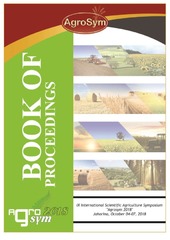Приказ основних података о документу
From the Gregor Mendel’s garden to a molecular marker lab: cutting edge of breeding grain and forage crucifers in Serbia
| dc.creator | Marjanović-Jeromela, Ana | |
| dc.creator | Miladinović, Dragana | |
| dc.creator | Mitrović, Petar | |
| dc.creator | Grahovac, Nada | |
| dc.creator | Dimitrijević, Aleksandra | |
| dc.creator | Rajković, Dragana | |
| dc.creator | Lazić, Sanja | |
| dc.creator | Šunjka, Dragana | |
| dc.creator | Mikić, Aleksandar | |
| dc.date.accessioned | 2021-10-15T12:29:26Z | |
| dc.date.available | 2021-10-15T12:29:26Z | |
| dc.date.issued | 2018 | |
| dc.identifier.isbn | 978-99976-718-8-2 | |
| dc.identifier.uri | http://fiver.ifvcns.rs/handle/123456789/2311 | |
| dc.description.abstract | A complex and strategically structured research on oil-rich grain, vegetable and forage crucifers at the Institute of Field and Vegetable Crops in Novi Sad (IFVCNS) is based upon maintaining and sustainably utilising the germplasm collections of each crop. It comprises conventional and molecular breeding, biotechnology, agroecology, physiology, biochemistry, agronomy and seed science as well as commercial production for local and international markets. Here, we shall focus on oil-rich grain and forage crops, namely rapeseed, black and white mustards, forage kale and false flax. All collected accessions of our collection were phenotypically and cytogenetically characterized, including the monitoring and examining flower morphology, pollen features and number of chromosomes. The Mendel's rules are the basis of all the methods in breeding cultivars and hybrids of oil and forage crucifers. Constant and systematic use of these fundamental genetic postulates has led to the development and official registration of 13 autumn-sown rapeseed cultivars and two hybrids, two spring-sown rapeseed, one black mustard, one oil-rich grain white mustard, three autumn-sown forage kale and one spring-sown forage white mustard cultivar, as well as two false flax lines. Today, the conventional breeding methods are closely followed by various molecular genetic tools. So far, the most prominent role in assisting the selection of the genotypes with desirable traits has been played by RAPD and SSR molecular markers. A well-designed and feasibly organized integration of the Mendel's rules, conventional breeding methods and molecular breeding tools are anticipated as significantly improving the existing programmes. It ensures that the future efforts will yield further progress in oil and forage crucifers’ research. This will benefit to various aspects of economy, especially the environment friendly production of quality oil for both human consumption and non-food industry and low-input and esteemed forage in ruminant feeding. | sr |
| dc.language.iso | en | sr |
| dc.publisher | East Sarajevo : University of East Sarajevo, Faculty of Agriculture | sr |
| dc.relation | info:eu-repo/grantAgreement/MESTD/Technological Development (TD or TR)/31025/RS// | sr |
| dc.rights | openAccess | sr |
| dc.rights.uri | https://creativecommons.org/licenses/by/4.0/ | |
| dc.source | Book of Proceedings, 9th International Scientific Agriculture Symposium "Agrosym 2018", Jahorina, 4-7 October 2018 | sr |
| dc.subject | breeding | sr |
| dc.subject | crucifers | sr |
| dc.subject | forage production | sr |
| dc.subject | oil production | sr |
| dc.subject | Serbia | sr |
| dc.title | From the Gregor Mendel’s garden to a molecular marker lab: cutting edge of breeding grain and forage crucifers in Serbia | sr |
| dc.type | conferenceObject | sr |
| dc.rights.license | BY | sr |
| dc.citation.epage | 295 | |
| dc.citation.spage | 290 | |
| dc.identifier.fulltext | http://fiver.ifvcns.rs/bitstream/id/6160/bitstream_6160.pdf | |
| dc.identifier.rcub | https://hdl.handle.net/21.15107/rcub_fiver_2311 | |
| dc.type.version | publishedVersion | sr |


